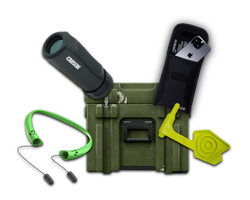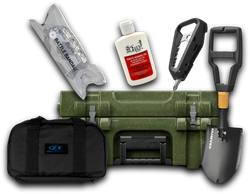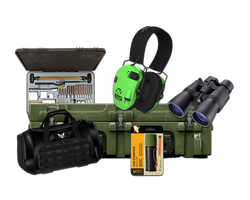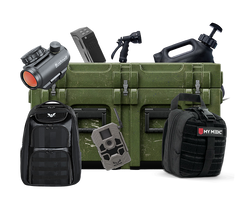How Close Can You Shoot Steel Targets? Understanding Safe Distances and Best Practices
Table of Contents
- Introduction
- Understanding Steel Targets
- Safe Distances for Shooting Steel Targets
- Mitigating Risks When Shooting Steel Targets
- Conclusion
- FAQ
Introduction
Imagine the satisfying ping of a bullet striking steel, the immediate feedback that lets you know you've hit your mark. For many shooting enthusiasts, steel targets are a staple in target practice, offering durability, auditory feedback, and a sense of accomplishment. However, a crucial question often arises: How close can you shoot steel targets? This query isn't just about convenience; it's fundamentally tied to safety and effective shooting practices.
Steel targets have gained popularity among shooters due to their longevity and the distinct sound of impact that paper or cardboard cannot replicate. Yet, the safe shooting distance can vary significantly based on multiple factors, including the type of firearm, caliber, angle of the target, and the steel's quality. Understanding these aspects is vital for anyone looking to incorporate steel targets into their practice routine.
In this blog post, we will explore the nuances of safe distances when shooting steel targets, the implications of different calibers, the importance of target quality, and best practices for mitigating risks associated with ricochets. By the end of this article, you'll have a comprehensive understanding of how close you can safely shoot steel targets, allowing you to enjoy your range time while prioritizing safety.
Understanding Steel Targets
The Appeal of Steel Targets
Steel targets are favored for several reasons:
- Instant Feedback: Unlike paper targets, steel provides immediate auditory feedback upon being hit.
- Durability: High-quality steel targets can withstand repeated shots, making them a cost-effective choice over time.
- Versatility: Steel targets can be used for various shooting disciplines, from handguns to rifles.
Types of Steel Used for Targets
Not all steel is created equal. The effectiveness and safety of shooting steel targets heavily depend on the type of steel used. The most common types include:
- AR500 Steel: This is the most widely used grade for steel targets, known for its hardness and resistance to deformation. It can handle a variety of calibers and is less likely to pit or fragment upon impact.
- AR550 Steel: This is even harder than AR500 and can withstand higher velocities, making it suitable for heavy calibers and frequent shooting.
- Mild Steel: Not recommended for serious shooting applications, as it is prone to warping and dangerous ricochets.
Choosing targets made from AR500 or AR550 ensures a safer shooting experience, as these materials are specifically engineered for repeated impacts.
Safe Distances for Shooting Steel Targets
General Guidelines
When it comes to determining how close you can shoot steel targets, a few general rules apply:
- The thicker the steel, the closer you can stand: Thicker steel targets are more resilient and can absorb more energy.
- The softer the bullet, the closer you can be: Frangible or lead bullets are less likely to cause ricochets compared to harder jacketed bullets.
- The larger the caliber, the further away you should be: Larger calibers produce more energy, necessitating a greater distance for safety.
Recommended Minimum Distances
Handguns
For handguns, the recommended minimum distance is generally around 10 to 15 yards. However, this can vary:
- Standard Ammo: For typical centerfire ammunition, 10 yards is acceptable.
- High-Caliber or High-Velocity Rounds: If using high-velocity ammunition, consider increasing the distance to 15 to 25 yards to avoid ricochets.
Rifles
When it comes to rifles, the safe distance increases significantly due to the higher energy levels:
- Minimum Distance: A distance of 100 yards is often recommended for most rifle calibers.
- Velocity Considerations: If you're shooting rounds exceeding 2850fps, it’s advisable to increase your distance even further.
Shotguns
For shotguns, the recommended minimum distance is generally 25 yards. This distance ensures that the spread of shot does not create a ricochet hazard.
Factors Affecting Safe Distances
-
Ammunition Type: Different types of ammunition can behave differently upon impact with steel. For instance, frangible rounds are less likely to cause ricochet than full metal jacket (FMJ) rounds.
-
Target Angle: Targets should ideally be angled downward. This helps direct bullet fragments into the ground, reducing the risk of them bouncing back towards the shooter.
-
Condition of the Target: Regularly inspect your steel targets for pitting, cracks, or dents. Damaged targets can increase the risk of ricochet and should be replaced immediately.
Mitigating Risks When Shooting Steel Targets
Best Practices for Shooting Steel Safely
-
Use Quality Targets: Always opt for high-quality AR500 or AR550 steel targets. These materials are less likely to deform and can withstand repeated impacts.
-
Angle Your Targets: Ensure that your steel targets are mounted at a downward angle. This will help deflect splatter towards the ground.
-
Maintain Safe Distances: Stick to the recommended minimum distances based on your firearm and ammunition type. When in doubt, err on the side of caution by increasing your distance.
-
Regular Inspections: Before and after shooting sessions, inspect your steel targets for any signs of damage. If you notice any issues, cease use immediately.
-
Wear Protective Gear: Always wear appropriate personal protective equipment, including safety glasses, to guard against any unexpected splatter.
Common Misconceptions
- "I can shoot closer if I angle the target." While angling helps, it doesn't eliminate all risks. Always adhere to recommended distances regardless of target angle.
- "Steel targets are completely safe." Steel targets can be safe if used correctly; however, they still pose risks, particularly from ricochet or splatter. Always prioritize safety.
Conclusion
Shooting steel targets can be an incredibly rewarding experience, offering immediate feedback and the durability that paper targets cannot provide. However, understanding how close you can shoot steel targets is essential for maintaining safety on the range. By adhering to recommended distances based on your firearm, ammunition, and target quality, you can enjoy your shooting sessions with peace of mind.
Remember, safety should always come first. By following the guidelines outlined in this article and being vigilant about the condition of your targets, you’ll create an enjoyable and secure shooting environment. For those looking to enhance their shooting experience, consider exploring Crate Club's subscription services, which offer a curated selection of high-quality tactical gear, including steel targets and other essential shooting accessories.
To further enrich your tactical experience, check out Crate Club's Subscription Services and Shop for a range of curated gear tailored to your needs.
FAQ
What is the minimum safe distance for shooting steel targets with a handgun?
The minimum safe distance for handguns is generally around 10 to 15 yards, depending on the caliber and type of ammunition used.
Can I shoot steel targets with a rifle from a closer distance?
No, it is generally recommended to maintain a distance of at least 100 yards when shooting steel targets with a rifle to ensure safety and minimize ricochet risks.
How does the quality of the steel affect shooting safety?
High-quality steel, such as AR500 or AR550, is designed to withstand repeated impacts without significant deformation, reducing the risk of ricochet and ensuring a safer shooting experience.
What should I do if my steel target shows signs of damage?
If your steel target has any visible damage, such as pitting or cracks, cease use immediately and replace the target to prevent safety hazards.
Are there any specific types of ammunition I should avoid using with steel targets?
It is advisable to avoid using armor-piercing or steel-core ammunition when shooting at steel targets, as these can increase the likelihood of ricochet and damage to the target.
Share this article



